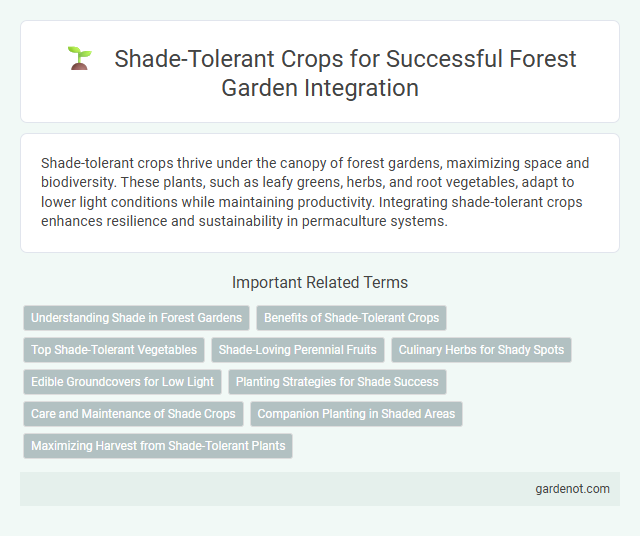Shade-tolerant crops thrive under the canopy of forest gardens, maximizing space and biodiversity. These plants, such as leafy greens, herbs, and root vegetables, adapt to lower light conditions while maintaining productivity. Integrating shade-tolerant crops enhances resilience and sustainability in permaculture systems.
Understanding Shade in Forest Gardens
Shade-tolerant crops in forest gardens thrive under low light conditions by efficiently utilizing filtered sunlight through the canopy layers. Species such as leafy greens, ginger, and certain mushrooms rely on adaptive traits like broad leaves and slow growth to maximize photosynthesis in shaded environments. Understanding the spectrum and intensity of shade helps optimize plant placement and enhances biodiversity within sustainable forest garden systems.
Benefits of Shade-Tolerant Crops
Shade-tolerant crops in forest gardens maximize land use by thriving under tree canopies, enhancing biodiversity and improving ecosystem resilience. These crops reduce water evaporation and soil erosion, promoting soil health and conserving moisture in shaded environments. Incorporating shade-tolerant plants like leafy greens, herbs, and root vegetables increases food production without disrupting the forest garden's natural balance.
Top Shade-Tolerant Vegetables
Top shade-tolerant vegetables for forest gardens include leafy greens like kale, spinach, and Swiss chard, which thrive under filtered sunlight. Root vegetables such as carrots and beets can also adapt to low-light conditions, making them ideal for shaded understory planting. Incorporating these crops improves biodiversity while maximizing productivity in shaded forest garden areas.
Shade-Loving Perennial Fruits
Shade-tolerant crops such as shade-loving perennial fruits thrive in low-light conditions typical of forest gardens, making them ideal for understory planting. Examples include American pawpaw (Asimina triloba), which produces nutrient-rich fruits, and hardy kiwifruit (Actinidia arguta), known for its high vitamin C content. These perennials enhance biodiversity, improve soil structure, and provide year-round harvests while conserving forest ecosystem health.
Culinary Herbs for Shady Spots
Shade-tolerant culinary herbs such as mint, chives, and parsley thrive in forest garden environments with limited sunlight, providing flavorful additions for culinary use. These herbs improve soil health by attracting beneficial insects and supporting biodiversity under tree canopies. Incorporating shade-loving herbs maximizes yield in low-light areas while enhancing the garden's ecological balance.
Edible Groundcovers for Low Light
Edible groundcovers like wild ginger, sweet woodruff, and creeping thyme thrive in low light conditions typical of forest gardens, enhancing soil health and suppressing weeds. These shade-tolerant crops provide nutritious leaves, roots, or berries while improving biodiversity and moisture retention under tree canopies. Incorporating such groundcovers maximizes yield in shaded areas, ensuring continuous food production without competing with taller plants.
Planting Strategies for Shade Success
Selecting shade-tolerant crops such as leafy greens, ferns, and certain root vegetables ensures improved growth under forest garden canopies. Incorporating layered planting strategies with taller trees providing dappled sunlight and understory plants thriving in low light maximizes productivity. Regular monitoring of light availability and staggered planting schedules help optimize crop yield in shaded environments.
Care and Maintenance of Shade Crops
Shade-tolerant crops in forest gardens require careful monitoring of soil moisture and nutrient levels to thrive under low light conditions. Regular pruning of surrounding canopy trees enhances light penetration while reducing competition for water and nutrients. Applying organic mulches preserves soil hydration, suppresses weeds, and fosters a beneficial microclimate crucial for the growth and resilience of shade crops.
Companion Planting in Shaded Areas
Shade-tolerant crops like ferns, ginger, and leafy greens thrive in forest garden understories by maximizing limited sunlight. Companion planting enhances growth by pairing these crops with nitrogen-fixing plants such as clover or legumes, improving soil fertility and moisture retention. Strategic layering mimics natural ecosystems, increasing biodiversity and resilience while optimizing space in shaded environments.
Maximizing Harvest from Shade-Tolerant Plants
Shade-tolerant crops such as kale, spinach, and ginger thrive in forest garden understories, efficiently utilizing low-light conditions to maximize yield. Selecting diverse shade-loving species improves biodiversity and enhances soil health, promoting sustainable productivity. Incorporating these plants strategically in shaded zones ensures continuous harvests while maintaining ecosystem balance.
Shade-tolerant crop Infographic

 gardenot.com
gardenot.com